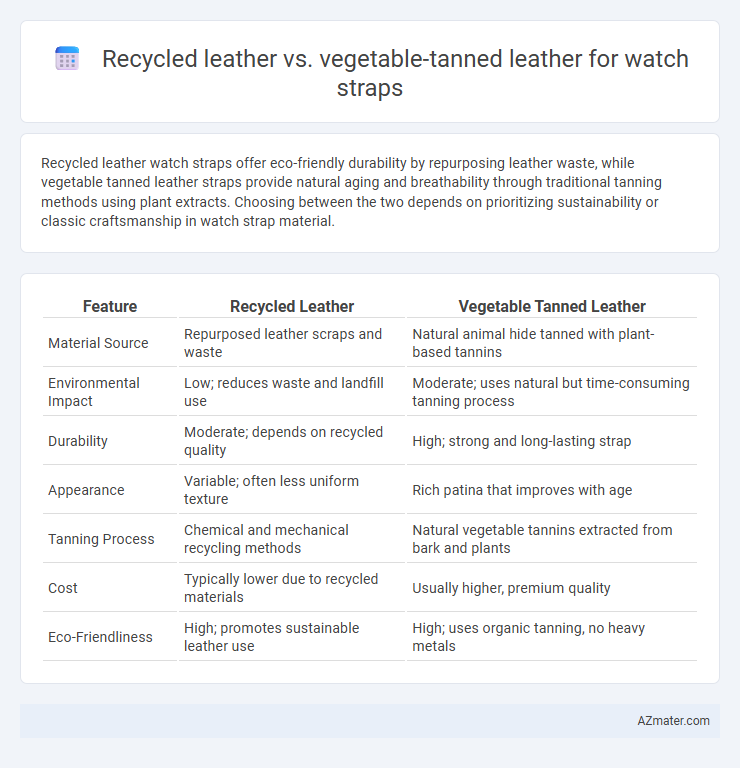Recycled leather watch straps offer eco-friendly durability by repurposing leather waste, while vegetable tanned leather straps provide natural aging and breathability through traditional tanning methods using plant extracts. Choosing between the two depends on prioritizing sustainability or classic craftsmanship in watch strap material.
Table of Comparison
| Feature | Recycled Leather | Vegetable Tanned Leather |
|---|---|---|
| Material Source | Repurposed leather scraps and waste | Natural animal hide tanned with plant-based tannins |
| Environmental Impact | Low; reduces waste and landfill use | Moderate; uses natural but time-consuming tanning process |
| Durability | Moderate; depends on recycled quality | High; strong and long-lasting strap |
| Appearance | Variable; often less uniform texture | Rich patina that improves with age |
| Tanning Process | Chemical and mechanical recycling methods | Natural vegetable tannins extracted from bark and plants |
| Cost | Typically lower due to recycled materials | Usually higher, premium quality |
| Eco-Friendliness | High; promotes sustainable leather use | High; uses organic tanning, no heavy metals |
Introduction to Watch Strap Materials
Recycled leather and vegetable-tanned leather are popular materials for watch straps, each offering unique benefits in sustainability and durability. Recycled leather is made from repurposed leather waste, reducing environmental impact while maintaining a natural leather appearance. Vegetable-tanned leather involves a traditional tanning process using plant extracts, providing a durable, eco-friendly, and chemically-free watch strap option.
What is Recycled Leather?
Recycled leather is a material made by grinding discarded leather scraps and fibers, then combining them with a binding agent to create a new, sustainable leather-like product ideal for watch straps. This process reduces waste and promotes eco-friendly practices in the fashion industry compared to vegetable tanned leather, which is produced through a natural tanning process using plant-based tannins. Recycled leather offers a cruelty-free alternative with a lower environmental impact while maintaining durability and aesthetic appeal for watch accessories.
What is Vegetable Tanned Leather?
Vegetable tanned leather is a natural, eco-friendly material crafted using tannins extracted from plant sources such as tree bark, leaves, and fruits, resulting in a durable and biodegradable watch strap option. It develops a unique patina over time, enhancing the aesthetic appeal while maintaining breathability and comfort on the wrist. Compared to recycled leather, vegetable tanned leather offers superior longevity and a more authentic, artisanal finish that ages gracefully with regular use.
Sustainability Comparison
Recycled leather watch straps significantly reduce environmental impact by repurposing existing leather scraps and minimizing landfill waste, while vegetable tanned leather involves natural tannins from plant sources, promoting biodegradability and avoiding harmful chemicals typical of chrome tanning. Recycled leather supports circular economy principles through resource optimization, whereas vegetable tanned leather emphasizes traditional, eco-friendly processing methods with lower toxic emissions. Both materials advance sustainability but differ in lifecycle impacts: recycled leather prioritizes waste reduction, and vegetable tanned leather focuses on non-toxic, renewable tanning processes.
Durability and Longevity
Recycled leather watch straps combine eco-friendly attributes with moderate durability, often holding up well under daily wear but generally showing faster patina and wear compared to vegetable tanned leather. Vegetable tanned leather is renowned for its exceptional longevity, developing a rich patina over time while maintaining structural integrity due to the natural tanning process using tannins from plant materials. For long-lasting watch straps, vegetable tanned leather provides superior resistance to stretching and cracking, making it a preferred choice for durability-conscious consumers.
Aesthetic Differences
Recycled leather watch straps exhibit a unique, distressed texture with color variations and an eco-conscious appeal, often featuring a matte finish that enhances their rugged charm. Vegetable tanned leather offers a rich, warm patina that deepens over time, showcasing natural grain patterns and a smooth, polished surface prized for its elegance. The aesthetic contrast lies in recycled leather's raw, textured look versus vegetable tanned leather's refined, classic appearance.
Comfort and Wearability
Recycled leather watch straps offer enhanced breathability and lightweight comfort due to their engineered fibers, reducing wrist sweat and irritation during extended wear. Vegetable tanned leather, known for its natural firmness and ability to mold over time, provides a personalized fit that improves comfort with age. While recycled leather excels in immediate softness and eco-friendliness, vegetable tanned leather delivers long-term durability and a classic, comfortable aging patina.
Environmental Impact
Recycled leather watch straps significantly reduce landfill waste by repurposing leather scraps and minimizing the need for new raw materials, lowering overall environmental footprint. Vegetable tanned leather involves natural plant-based tannins, resulting in a biodegradable and non-toxic product, but the tanning process consumes substantial water and time. Choosing recycled leather supports circular economy principles, whereas vegetable tanned leather emphasizes sustainable sourcing and lower chemical use during production.
Cost Comparison
Recycled leather watch straps generally cost less than vegetable tanned leather due to lower production expenses and the reuse of existing materials. Vegetable tanned leather involves a more time-intensive process using natural tannins, resulting in higher manufacturing costs and premium pricing. Consumers seeking budget-friendly options often prefer recycled leather, while those valuing durability and traditional craftsmanship lean towards vegetable tanned leather despite the higher cost.
Which Leather is Right for Your Watch Strap?
Recycled leather offers an eco-friendly, budget-conscious choice with a unique texture derived from repurposed materials, making it ideal for sustainable watch straps. Vegetable tanned leather provides durability, a rich patina over time, and a more natural, chemical-free tanning process, appealing to those seeking traditional craftsmanship and longevity. Choosing between them depends on whether you prioritize environmental impact and cost-effectiveness or classic quality and aging character for your watch strap.

Infographic: Recycled leather vs Vegetable tanned leather for Watch strap
 azmater.com
azmater.com